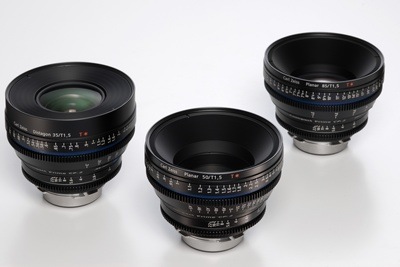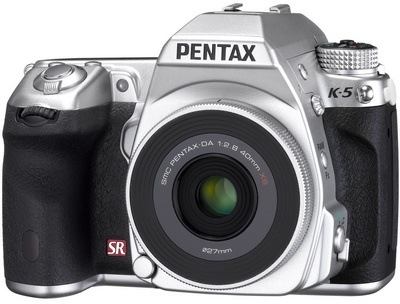18/04/12
New GoPro Protune with Technicolor CineStyle color profile
17/04/12
Carl Zeiss New CP.2 Super Speed lenses presented at NAB 2012
Three new Super Speed cine lenses are presented by Carl Zeiss at NAB 2012 : the Compact Prime CP.2 35/T1.5, Compact Prime CP.2 50/T1.5, Compact Prime CP.2 85/T1.5 Super Speed
 Three new Compact Prime CP.2 Super Speed lenses with a T-stop of 1.5
Three new Compact Prime CP.2 Super Speed lenses with a T-stop of 1.5
Photo: Courtesy of Carl Zeiss
Available with a fast T1.5 aperture and in focal lengths of 35mm, 50mm and 85mm, the new Compact Prime CP.2 Super Speed lenses offer filmmakers new opportunities for shooting in low-light conditions. Like the other Compact Prime CP.2 lenses, the new Super Speed lenses cover a full-frame sensor format and are equipped with the interchangeable lens mount system for use with a variety of cameras ranging from HDSLR to professional cinema cameras.
“With the new Compact Prime CP.2 Super Speed lenses with a fast T-stop of T1.5, we expand our family of CP.2 lenses with an even more powerful choice of lenses”, says Michael Schiehlen, Sales Director of the Carl Zeiss Camera Lens Division. “This opens up new creative possibilities in low-light situations, especially with the new high ISO HDSLR’s and HD video cameras. The Super Speed name has a long history at Carl Zeiss and these new lenses are a fitting tribute to their legacy”.
The faster T1.5 aperture is one of the key advantages to the Compact Prime CP.2 Super Speed lenses, especially for night-time shots or under low-light conditions. This helps to limit the need for artificial light, delivering more natural looking scenes with less effort and expense.
The cinematographer Sebastian Wiegärtner has tested the Compact Prime CP.2 Super Speed lenses and was very enthusiastic about the faster aperture while shooting a short film: “We filmed for three days in outdoor locations, with about eighty percent of the shots being taken at night. During the medieval-looking filming of two actors, the faster aperture was particularly effective by using lighting accents in the form of torchlight. The resulting images achieved the desired look and were appropriately stylish and soft.”
As with the rest of the CP.2 family, the Compact Prime CP.2 Super Speed lenses feature a 14-blade aperture, which creates a round iris opening and a natural, out of focus rendition. The standard cine-style housing with gearing allows the attachment of any standard follow-focus system. A long, 300 degree focus rotation and smooth action provides fine control, which is especially important given the shallow depth-of-field when using these lenses at wide open aperture. By using the interchangeable mounts for PL, EF, F, MFT and E, the Compact Prime CP.2 Super Speed lenses can be easily adapted to numerous camera systems and ensures compatibility with future cameras as technology changes. Carl Zeiss T* anti-reflection coating ensures the maximum contrast and color rendition by minimizing stray light and ghosting within the lens.
The Compact Prime CP.2 Super Speed lenses can be purchased individually, or combined as set with other Compact Prime CP.2 lenses in the product line.
The lenses will be shipped in August 2012. The recommended retail price for the Compact Prime CP.2 35/T1.5 Super Speed is €3,700 or US$4,900 (excluding VAT)*. The recommended retail price for the Compact Prime CP.2 50/T1.5 Super Speed and Compact Prime CP.2 85/T1.5 Super Speed is €3,300 or US$4,500 (excluding VAT)*. * Status: 16 April, 2012
16/04/12
Allen DeBevoise and Teri Hatcher at the 2012 NAB Show, Las Vegas, Nevada
Teri Hatcher to host the 2012 NAB Show General Session
Today, Monday, April 16, Golden Globe-winning actress Teri Hatcher will host the General Session at the 2012 NAB Show.
Teri Hatcher currently stars as Susan Mayer on the ABC comedy-drama series "Desperate Housewives." Her acting on the show has earned her a 2005 Golden Globe Award (Best Actress in a Leading Role, Musical or Comedy, Television), a 2005 Screen Actors Guild Award (Outstanding Performance by a Female Actor in a Comedy Series), a 2006 Golden Globe Award nomination, a 2005 Television Critics Award nomination and a 2005 Emmy Award nomination for Outstanding Lead Actress in a Comedy. Hatcher previously starred as Lois Lane in the ABC series "Lois & Clark: The New Adventures of Superman" from 1993 to 1997, and recently guest starred as Lois Lane's mother, Ella Lane, on an episode of "Smallville." Other television credits include roles on "The Love Boat," "MacGyver," "Star Trek: The Next Generation," "Murphy Brown," "Fraiser" and "Seinfeld."
Teri Hatcher made her film debut in the Christopher Guest-directed "The Big Picture" (1989). She has also made appearances in films such as "Soapdish" (1991), "2 Days in the Valley" (1996), "Tomorrow Never Dies" (1997) and "Spy Kids" (2001). She also had the starring role as Sally Bowels in the Sam Mendes-directed touring company of "Cabaret" in 1999. In 2006, Hatcher wrote "Burnt Toast and Other Philosophies of Life," which remained on The New York Times Best Seller list for four weeks.
15/04/12
Larry Rivers at Tibor de Nagy Gallery, NYC
Tibor de Nagy Gallery, New York
April 26 - June 15, 2012
"Rivers understood time’s devastations and in many of his late works he registered them with a firm but sensitive eye and hand. He explored the pleasure and sorrow of memory, even as he acknowledged time would eventually erase them. He understood that the present buried the past, and that it was up to us to remember the Holocaust for the next generation, however difficult and painful that might be. This is what we have to recognize about Rivers’s late work. He wasn’t thinking about his reputation, and whether or not he would be forgotten. He was chronicling what it meant to be an aged man living in time—both personal and historical—and all that it stirred up in him.
TIBOR DE NAGY GALLERY
www.tibordenagy.com
13/04/12
Art and Design of Contemporary Jewellery at the National Gallery of Victoria, Australia - NGV International, St Kilda
National Gallery of Victoria, Melbourne
21 April - 26 August 2012
Among the exhibited artists is the Danish artist Camilla Prasch.
MEGA 2009
red dyed snap fasteness, nylon thread, silicone discs
31 x 11 cm
Collection of the artist
© Camilla Prasch
Photo : Dorte Krogh
NGV International
180 St Kilda Road
Museum's website: www.ngv.vic.gov.au
Edition Video Pro : Adobe Production Premium CS6 au NAB 2012
Adobe présentera la semaine prochaine la nouvelle version de sa suite de logiciels dédiés à la vidéo professionnelle incluant Adobe Premiere Pro. La Creative Suite 6 Production Premium sera présentée au NAB 2012 (National Association of Broadcasters) qui se tient du 16 au 19 avril au Las Vegas Convention Center. Dans son communiqué de presse, Adobe qualifie de "majeures" les mises à niveau apportées à la suite de logiciels qui sera disponible dans le courant de se premier semestre 2012.
La CS6 Production Premium inclus SpeedGrade CS6 pour l'étalonnage et Prelude CS6 qui améliore l’assimilation, la journalisation et le transcodage. Premiere Pro CS6 est doté d'une nouvelle interface utilisateur et son moteur de lecture Adobe Mercury permet la prise en charge d'OpenCL. After Effects CS6 voit les fonctionnalités 3D du logiciel améliorées.
Pour plus d’infos (en anglais) :
http://success.adobe.com/en/na/programs/events/1203_16108_nab.html..
11/04/12
Pentax K5 Edition spéciale limitée à 1500 exemplaires en couleurs noir & argent
Suivant une pratique déjà adoptée pour d’autres modèles, Pentax a sortie une édition spéciale de son reflex numérique K-5 en couleur argentée : le Pentax K5 Silver Special Edition. Cette édition spéciale est limitée puisque l'appareil photo n'a été produit qu'à 1500 exemplaires pour l'ensemble du marché mondial.
 Photo de l’édition spéciale du Pentax K-5 produit à 1500 exemplaires. Courtesy © Pentax Ricoh Imaging Company, Ltd.
Photo de l’édition spéciale du Pentax K-5 produit à 1500 exemplaires. Courtesy © Pentax Ricoh Imaging Company, Ltd.
Le kit inclus l'objectif Pentax DA 40 mm F2.8 XS. Cet objectif lumineux de qualité, d'un poids de 52 g, est l'objectif interchangeable à focale fixe pour reflex numérique le plus court du marché puisqu'il mesure moins de 1 cm de longueur : 9,2 mm. Il a été dessiné par le designer Marc Newson, une des figures connue du design industriel.
Comme vous pouvez le voir sur la photo, le design est sobre, harmonieux. Il situe le design de l'appareil photo numérique en continuité avec les plus beaux des appareils argentiques classiques avec une touche plus contemporaine pour la partie recevant l'objectif. Le Pentax K-5 se distingue ainsi du look plus retro de l’édition limitée du Pentax Q (l’aspect retro ressort davantage du modèle en version limitée en gris métallisé qu’en version standard) et du caractère un peu plus ostentatoire (couleur) de l’édition spéciale du moyen-format 645D. Comme pour les précédentes éditions spéciales, la finition est très soignée et a de quoi séduire les amoureux de la marque et, parmi eux, ceux qui sont collectionneurs.
Cette édition limitée du Pentax K-5 aux couleurs argent et noir a d'un point de vue technique les mêmes caractéristiques que le modèle standard. Son firmware est le dernier en date : version 1.13.
 Photo de l’édition spéciale du Pentax Q produit à 1600 exemplaires. Courtesy © Pentax Ricoh Imaging Company, Ltd.
Photo de l’édition spéciale du Pentax Q produit à 1600 exemplaires. Courtesy © Pentax Ricoh Imaging Company, Ltd.

Photo de la très belle édition spéciale du Pentax Moyen Format 645D. Courtesy © Pentax Ricoh Imaging Company, Ltd.
08/04/12
Bernard Dufour: Manipulations, Maison des Arts Georges Pompidou, Carjac
« Tout mêler ou plutôt tout se faire succéder pour tout empiler, à la façon du temps dans son incoercible écoulement. Faire : ne rien retenir, ne rien privilégier… Comme si ce que je fais à l’atelier, quand j’y suis, n’était rien d’autre que l’image de ma vie. Devait n’être rien d’autre que l’image de ma vie. »
« Il me plaît beaucoup que l’usage crée chez moi de nouvelles choses, de même que l’usage de telle ou telle technique, inventent comme moi, autant que moi, au même titre que moi, dans une multiplication enchaînée et rebondissante des contraintes, des matériaux, donc de mes mains. »
07/04/12
August Sander @ Edwynn Houk Gallery, NYC - Citizens of the Twentieth Century
Edwynn Houk Gallery, New York
5 April - 26 May, 2012
EDWYNN HOUK GALLERY
745 Fifth Avenue, New York, NY 10151
www.houkgallery.com
04/04/12
Women on the verge at Empty Quarter, Dubai, featured women photographers from the Middle East
Women on the verge
Empty Quarter gallery, Dubai, UAE
March 20 - April 30, 2012
 |
| The Empty Quarter, Fine Art Photography, Dubai, UAE |
"My dear women! you have revolted from all over the country of Yemen, Tunisia, Egypt, Libya and Syria in order to construct a dignified life and a better future. Therefore, there is no way that we should bend down or go back. [...]I do believe that the prosperous future is for women, and it is we who make the dreams come true and a better future. It is she who creates dignity and liberty. Thus, whatever that has accomplished was a collaboration between men and women alike. One of the necessities of partnership is for the woman to obtain her full rights. No dignity and no liberty for a nation which oppresses women and take away their rights." - Tawakkol Karman, Noble Peace Prize Laureate, 2011.
Larissa Sansour - Palestine
Laura El Tantawy - Egypt
Boushra Almutawakel - Yemen
Newsha Tavakolian - Iran
Leila Alaoui - Morocco
Rania Matar - Lebanon
Waheeda Malullah - Bahrein
Tanya Habjouqa - Jordania
Laura Boushnak - Palestine
Tanya Traboulsi - Lebanon
Hind Mezaina - UAE
Dalia Khamissy - Lebanon
Myriam Abdelaziz - Egypt
Eman Mohammed - Palestinian National Authority
THE EMPTY QUARTER GALLERY, DUBAI, UAE
www.theemptyquarter.com




